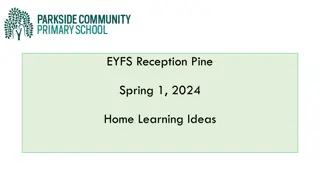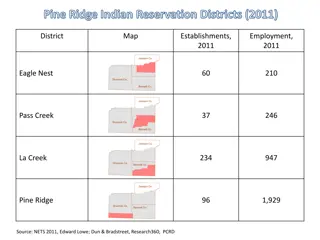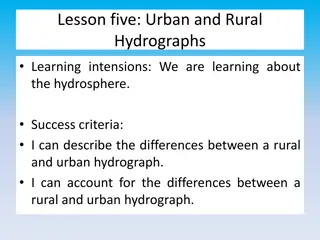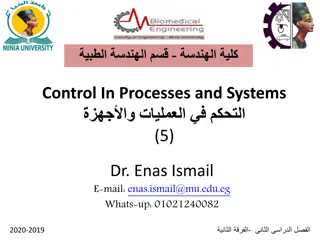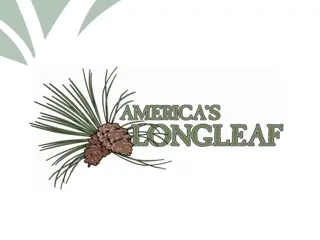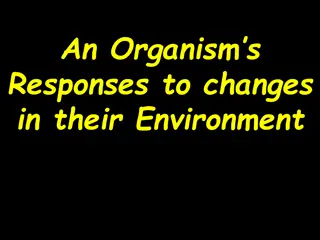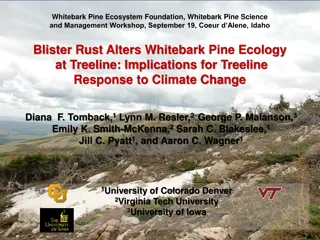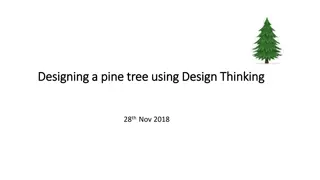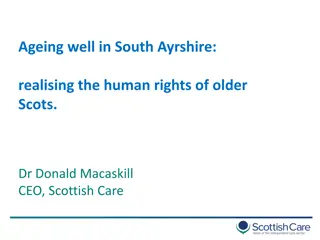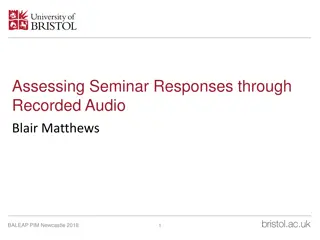Contrasting Responses of Mistletoe and Scots Pine in Pfynwald Study
The research investigates the distinct responses of mistletoe and Scots pine in the Pfynwald forest. The study explores the dynamics of carbon and nutrient uptake by mistletoes from host trees under varying environmental conditions. Hypotheses include the impact of tree irrigation on photosynthesis rates and the effects of girdling on carbon assimilation. Leaf traits like leaf mass per area (LMA) and water content differ between mistletoe and pine needles. The findings shed light on the intricate relationship between mistletoe and host trees.
Download Presentation

Please find below an Image/Link to download the presentation.
The content on the website is provided AS IS for your information and personal use only. It may not be sold, licensed, or shared on other websites without obtaining consent from the author. Download presentation by click this link. If you encounter any issues during the download, it is possible that the publisher has removed the file from their server.
E N D
Presentation Transcript
Different response of mistletoe and Scots pine in Pfynwald Ao Wang, Marco M. Lehmann, Andreas Rigling, Matthias Saurer, Arthur Gessler, Zhong Du, Mai-He Li
Background No study has actually shown that mistletoe could directly absorb carbon resources from host tissues. There is only some indirect evidence, based on comparable seasonal variations of sugar concentrations in the host and mistletoe xylem. Few studies have focused on the nutrient and carbon uptake by mistletoes from the host and the different absorption rates under varying environmental condition (i.e. soil drought and sufficient soil water), also the dynamics and the controlling factors of this relationship between mistletoe and host are still unclear.
Experiment Design (A) Wrapping Wrapping experiment Non-wrapped Non-girdled (B) Girdling & Non-removal Girdling and Removal experiment Girdling & Remove needles Girdling & Remove mistletoes
Hypothesis 1) Mistletoes can photosynthesis itself but not directly take up carbon assimilates directly from the host tree, and the photosynthesis rate will be higher in irrigated trees comparing to the non-irrigated trees; 2) Mistletoes will benefit and take up more carbon resource when transportation from the needles to other tissues was blocked (girdling vs non- girdled control), especially in the relative stressed condition (non-irrigated vs irrigated); 3) If, however, host source activity is impaired (girdling + needle removal), mistletoes could perform as a source tissues and transfer carbon assimilates to sink tissues of the host, which will be more conspicuous when the host tress grown in relative drought stressed conditions
Leaf mass per area (LMA) was significant higher in control pine needles than in the irrigated ones, but the mistletoe leaves showed the opposite pattern Leaf water content was higher in control compared to irrigated mistletoe leaves. Figure 2 Comparison of the leaf traits between Pinus Sylvestris and Viscum album ssp. Austriacum. (a) Leaf mass per area (LMA) of mistletoe leaves and pine needles in different irrigation treatment. (b) Leaf water content of mistletoe leaves and pine needles in different soil moisture treatment. (c) Single leaf area of mistletoe leaves and pine needles in different soil moisture treatment. Mistletoe had bigger leaves under dry control conditions.
Strong labelling effect was found on the non- wrapped mistletoe leaves and stems but not in wrapping ones. The peak value occurred after around 8 hours after labelling, which had an approximately 4 hours lag after the labelling. The 13C values reached the peak value in mistletoe stems as soon as the labelling event finished, Figure 3: Incorporation of 13C-label into assimilates for mistletoe leaves and stems in different wrapping treatment (i.e. wrapped/ not) after exposure to a 4 h 13C-enriched CO2labelling event (shaded area) and during the period. Please note the initial point (one day before the labelling) and scale of the x-axis variation (n=3 per individual treatment).
Table 1: Results of linear mixed models for 13C values (uptake and incorporation of 13C of bulk material in different tissues of Pinus Sylvestris and Viscum album ssp. Austriacum of the girdling and removal experiment. Tissue Factors Time Needle Irrigation Girdling Time Phloem Irrigation Girding Time Xylem Irrigation Girding Time Mistletoe leaf Irrigation Girding Tissue Factors Time Needle Irrigation Removal Time Phloem Irrigation Removal Time Xylem Irrigation Removal Time Mistletoe leaf Irrigation Needle Removal *P<0.05, **P<0.01, ***P<0.001 Girdling Experiment 13C <0.001*** 0.88 0.12 0.002** 0.44 0.20 0.20 0.72 0.35 <0.001*** 0.07 0.51 df 6 1 1 Irrigation treatment had no effect on13C incorporation and nitrogen concentrations in all pine tissues. 6 1 1 6 1 1 6 1 1 Removal Experiment Either mistletoe removal or needle removal affected the13C incorporation in tissues. 13C <0.001*** 0.77 <0.001*** <0.001*** 0.69 0.002** 0.01** 0.73 <0.001*** <0.001*** 0.03* <0.001*** df 6 1 1 6 1 2 6 1 2 6 1 1 .
Table 2: Results of linear mixed models for concentration of NSC (the increase percentage of non-structural carbohydrate during the period) and its compounds (i.e. sugar & starch) in two sub-experiments which based on the 13C labelling experiment. Girdling Experiment Factors Time Irrigation Girdling Time Irrigation Girding Time Irrigation Girding Time Irrigation Girding df 4 1 1 4 1 1 4 1 1 4 1 1 Sugar 0.57 0.93 0.04* 0.02** 0.82 <0.001*** 0.04* 0.72 0.03* 0.03* 0.62 0.12 Starch 0.32 0.23 0.02* <0.001*** 0.47 0.03* 0.96 0.37 0.95 0.25 0.16 0.57 Tissue NSC 0.49 0.45 0.008** 0.41 0.46 <0.001*** 0.38 0.60 0.14 0.18 0.16 0.28 For girdling experiment, NSC concentrations were not affected by irrigation treatments in pine tissues. Needle Phloem Xylem For removal experiment, irrigation treatments did not affect pine tissues. However, NSC in mistletoe leaves were affected by different irrigation treatments. Meanwhile, removal treatments had effects on pine tissues but not for mistletoe leaves. Mistletoe leaf Removal Experiment Factors Time Irrigation Mistletoe Removal Time Irrigation Removal Time Irrigation Removal Time Irrigation Needle Removal df 4 1 1 4 1 2 4 1 2 4 1 1 NSC 0.59 0.88 0.05* 0.88 0.29 0.008** 0.02* 0.15 <0.001*** 0.56 0.03* 0.40 Sugar 0.98 0.82 0.76 0.08 0.95 0.25 0.06 0.09 <0.001*** 0.01** 0.20 0.27 Starch 0.60 0.75 0.05* 0.17 0.16 0.05* 0.46 0.46 0.11 0.84 0.04* 0.19 Tissue Needle Phloem Xylem Mistletoe leaf *P<0.05, **P<0.01, ***P<0.001
Girdling treatment significantly decrease the peak value of 13C incorporation in needles and phloem during the labelling period. The incorporation of 13C in sink tissues (i.e. phloem & xylem) had an approximately 20 hours lag effect compared to the needles under the girdling treatment. Girdling treatment did not affect the 13C uptake and nutrient allocation of mistletoe leaves during the labelling period. Figure 4: Girdling effect (one day before the labelling, i.e. initial point) on Incorporation of13C-label into assimilates ( 13C values) of bulk ( 13Cbulk) in different pine (Pinus Sylvestris) and mistletoe (Viscum album ssp. Austriacum) tissues after exposure to a 4 h 13C-enriched CO2labelling event (shaded area).
NSC concentration in needles significantly increased after girdling. However, NSC in mistletoe leaves were not affected by girdling treatment. Figure 5: Girdling effect (one day before the labelling, i.e. initial point) on the increase of non- structural carbohydrate (%) in different pine (Pinus Sylvestris) and mistletoe (Viscum album ssp. Austriacum) tissues during the period. Please note the scale of the x-axis variation and y-axis change between upper and lower panel (n=3 per individual treatment).
Mistletoe leaves showed a higher 13C incorporation in the non-irrigated treatment, when the needles were removed from the branches. Removing the needles from the girdled branches significantly decreased the13C incorporation in the branch sink tissues of pine (i.e. phloem & xylem). When mistletoe leaves were removed from the branches, 13C incorporation decreased in all pine tissues. Figure 6: Incorporation of13C-label into assimilates ( 13C values) of bulk ( 13Cbulk) in different pine (Pinus Sylvestris) and mistletoe (Viscum album ssp. Austriacum) tissues under different removal treatments (i.e. needle removal/ mistletoe removal) and exposure to a 4 h13C-enriched CO2labelling event (shaded area) on girdling (one day before the labelling, i.e. initial point) branches.
For mistletoe leaves, NSC concentration significantly decreased in the non- irrigated treatment compared to irrigated treatment, independent if pine needles were removed or not. Either pine needles or mistletoe leaves removal decreased the concentration of NSC in the pine branch sink tissues over the sampling period. The same occurred in pine needles. Figure 7: Increase of non-structural carbohydrate (%) in different pine (Pinus Sylvestris) and mistletoe (Viscum album ssp. Austriacum) tissues under different removal treatments (i.e. needle removal/ mistletoe removal) on girdling (one day before the labelling, i.e. initial point) branches.
Conclusion 1. No 13C signal in the wrapping mistletoe leaves, indicating that there was no C-transfer from the host to the mistletoes via the phloem sap. Lower carbon assimilates in mistletoes compared with the hosts can be included by the high transpiration and low gross photosynthesis rate of mistletoes. 2. Girdling treatment could result in a higher NSC concentrations and carbon in pine tissues, but not for mistletoe leaves, indicating a kind of negative feedback on photosynthesis because of the carbon transportation was cut off. 3. When needles were completely removed from the girdled branches, host xylem and phloem were still able to acquire 13C from the mistletoes. Those results suggest that mistletoes can support the host with carbon resources, especially when the host is C resource limited (needle removal + girdling). Mistletoes may play a role as C source providers to support the host and maintain a symbiotic relationship to survive.



